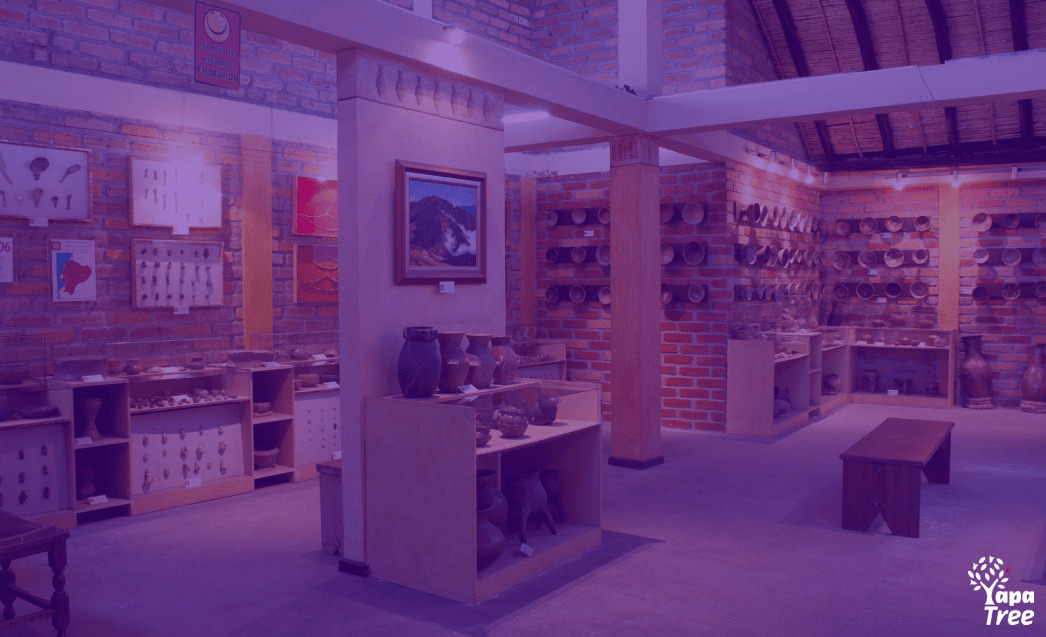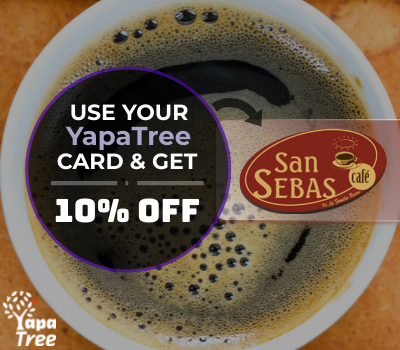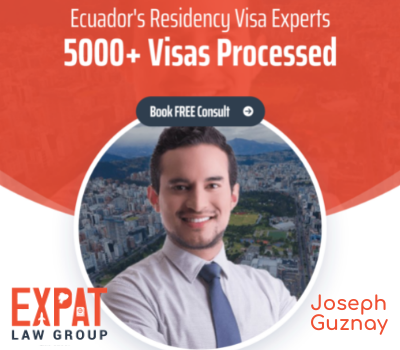The Museum of Aboriginal Cultures (Museo de las Culturas Aborígenes), located at Calle Larga 5-24, near the intersection of Calle Larga and Mariano Cueva, is a must-see for anyone interested in the pre-Columbian cultures of Ecuador.
At the entrance to the museum, there’s an inscription on the wall: “Cuenca tesoro escondido del Ecuador. Este Museo tesoro escondido de Cuenca.” This translates as “Cuenca is the hidden treasure of Ecuador. This museum is the hidden treasure of Cuenca.” I think it’s a fitting inscription for the place.
From the outside, it doesn’t look like much. I had walked by it many times but passed it by in favor of other attractions. As they say, you can’t judge a book by its cover. In this case, you can’t judge a museum by its entrance. It turns out to be a real highlight among Cuenca museums and natural history museums of my personal experience.
I like learning about history and cultures, so this museum was on my “to visit” list for a while. The only reason I had not visited it previously was that, from the outside, it looks unremarkable. I figured it would be an interesting way to spend fifteen minutes or so. What I found instead, “the hidden treasure of Cuenca,” was a welcome surprise. My wife and I spent nearly two hours wandering through the exhibits, learning about the cultural history of our adopted home.

Arrival
The man who greeted us, Dr. Juan Cordero Iñiguez, was kind and welcoming. As you will see in the Background section, he was the driving force behind this museum. It started as his personal collection and, after much work by him and a team of assistants, developed into a treasure trove of information and artifacts. His pride in the museum was obvious. The fee was four dollars for each of us, and another two to purchase a guidebook. I think you can borrow the guidebook and return it before leaving, though.
Background

The museum started as the personal collection of Dr. Cordero. He used items from his collection to complement the courses and lectures he taught at the University of Cuenca and the University of Azuay.
The collection, covering 15,000 years of Cuenca history, grew until, in 1992, it was large enough to open to the general public. This opening coincided with the 500th anniversary of Christopher Columbus’s arrival in the Americas, but the museum focuses on pre-Columbian cultures. The museum’s formal dedication is: “Ecuadorian Indian in its Fifteen Thousand Years of Existence.”
Since 1992, innumerable students from all levels have attended classes at the museum. National and foreign visitors have walked through the museum and learned about the rich cultures of Ecuador’s past.
Anita López Moreno, Dr. Cordero’s wife, has been instrumental in the museum’s success since it opened to the public. Their children have also provided help and support. The museum is a family endeavor, and their passion for its care is evident in both the curation of the artifacts and the ambiance of the place itself.
As a kid, I hated history, because, in the US public school system, it’s almost always taught as a cold, dry memorization of names and dates. As I got older and experienced some historical events firsthand, the value of history became more apparent, and I started caring less about names and dates and focused on the people and the effects of events on their lives. As such, a museum allows me to interact, at least visually, with actual items touched and used by those people. It makes learning about history even more vibrant for me. If you feel similarly, then this museum will fascinate you as much as it did me and my wife. I am going to talk about the various cultures represented in the museum from the Stone Age through the Inca.
Cultures Represented In the Museum
Take a deep breath and enjoy the many periods described below in the general categories of ‘The Lithics’ and ‘Formative Cultures’.
The Lithics

In this section of the museum, you’ll see fossils found throughout Ecuador, some dating back millions of years. The earliest artifacts of human make are around fifteen thousand years old and include points for spears and arrows, files, scrapers, and polishers. There are a variety of stone axe heads in a variety of shapes, including some star-shaped heads.
There are a variety of other items that were used in domestic life such as mortar and pestle sets, grinding stones, fishing weights, and personal ornamentation. The items that I found most interesting were the lithophones. These were stone bells. One set resembles a wind chime, and a larger one is a set of stones suspended in a series from a pole. This highlights the importance of music in the cultures of this region throughout history.
Formative Cultures (4,000 BCE – 500 BCE)
Evidence from this period shows the regional inhabitants settling into a more agrarian society. They became more focused on permanent housing, rituals, urban centers, and the development of ceramics.
Valdivia

One of the oldest cultures in the entire American continent, it is named after a small town located on the peninsula of Santa Elena in the southwest of Ecuador. The examples of their culture in the museum include a variety of containers with forty decorative techniques, the first human sculptures, and the VENUSES carved with feminine forms. There is a wide variety in these forms with different hairstyles and headdresses. They were used during fertility ceremonies for women and the Earth.
Machalilla

From the Manabi region, the Machalilla often used seashells to fashion utensils, hooks, and containers. Their ceramic sculptures, especially their whistle bottles with short spouts, started a tradition of craftsmanship that spread through the coastal region of Ecuador and flourished in Peru.
Chorrera

They used advanced manufacturing methods to produce amazingly detailed ceramic objects. They excelled in anthropomorphic (figures resembling humans), zoomorphic (figures resembling animals), phytomorphic (figures resembling plants), and even mixed representations with realism and fantastic stylizations. Their figurines depicted aspects of nature with excellent designs, and their use of bicolored palettes, lacquer, and polished paint make their work vibrant, even after millennia.
Along with their pottery, the Chorrera culture is known for their stone carving skills. They created stone figurines and other objects, showcasing their artistic abilities.
Narrío

This group provides us with the oldest pottery in the Azuay province, where Cuenca is located. The vessels they created were thin-walled, like eggshells. As such, few examples survive intact, but among the items in the museum, there are singular artifacts known as Rucuyayas or Ucuyayas. These were small sculptures made of shells in the form of elongated fangs. They represented the ancestors, protectors, and bearers of life. They were fashioned into talismans or medals and buried with people to provide good fortune on their journey into the afterlife.
Many of these were made from the valves of the Spondylus shell, a sacred shell unique to the Ecuadorian coast.
Regional Development Cultures (500 BCE – 500 CE)
La Tolita

Centered on La Tola Island, north of the Esmeraldas Province, this culture lived in a warm, humid, and fertile area, rich in vegetation and fauna. The natural world inspired the pottery of the region’s inhabitants. They crafted figures both natural and supernatural.
It is believed that the island was a ceremonial center where they produced pieces to be offered to their deities and sent with loved ones to the afterlife. On the island, they have discovered countless solid and hollow figurines depicting humans of all ages and some with cadaverous features. The living figures showed people doing various chores and tasks of everyday life. The cadaverous figures indicate some of the diseases they endured. They also found molds for the mass production of these items.
The variety of figurines found on the island include detailed representations of humans with special attention paid to their facial expressions and body language. Some involve erotic acts while others show women giving birth or breastfeeding children. Figures of dancers in full regalia, divers, and trophy figures lead to hypotheses about ancient migratory currents from Asia and Africa.
Representations of various animals are also abundant, as are anthropomorphized deities. Examples of masks, graters, and containers tell of the amazing diversity of their crafts. They even had funeral pots that sealed and others that prevented seawater from entering.
Jama Coaque

The Jama Coaque culture flourished in the northern coastal region of the Manabí province. Their art had a baroque aspect to it. Their human figures display elegant attire with an abundance of necklaces and bracelets.
Their sculpted figures depict bird men, dancers, seated women, some with children, shamans, water bearers, and thinkers. Their containers are adorned with detailed carvings of plants and animals.
They also made cylindrical seals used to identify individuals or families. These seals have a wide variety of designs ranging from natural to stylized and real to magical.
Bahía

They lived in the coastal region north of Guayaquil and south of Quito, which is affected by the Humboldt current and has less rainfall and vegetation than its neighboring areas. The Bahía culture from this region created pottery with various anthropomorphic and zoomorphic qualities. Some of the forms defy ready explanation.
They also made representations of shamans with tools, conjoined twins, whistles, elders, musicians with instruments, and acrobats. Their pottery is characterized by its red and black color scheme.
Noted for their metallurgical skills, they worked with metals such as gold, silver, and copper to create jewelry, ornaments, and tools.
Guangala Culture

Occupying the ancient sites of the Valdivia culture in the Guayas, the Guangala people were avid hunters, and their passion for the activity is evident in their art. Some of the designs among these artifacts have inspired various logos for modern institutions such as the National Congress and the House of Culture.
The Guangala people were skilled potters and produced a distinctive style of pottery known as “Guangala ware.” Their pottery often featured intricate designs and decorative elements, including zoomorphic and anthropomorphic motifs. They also created clay figurines and other ceramic objects.
Their jewelry was fashioned from Mother of Pearl along with shells and stones. There are some beautiful examples in the museum.
Cultures of Regional Development and Integration (500 BCE – 1500 CE)
Carchi Negative

There is currently no way to date many of the artifacts from archaeological studies of the Sierra region from this time period, so it is not possible to distinguish one culture from another. The term Carchi Negative is used to refer to a mixture of cultures from the Sierra region during this time period. The term relates to mastering a decorative technique that used wax, ash, and honey to create images with high contrast.
A noteworthy characteristic of this period and region are figures of seated shamans who have a bump on their cheeks. They are called coquero or “chewers of coca leaves.” They formed a large ball of leaves and kept it in their mouths for long periods of time.
A couple of cultures that could be identified are the Panzaleo and Tacalshapa.
Panzaleo

The Panzaleo, also known as Cosanga-Píllo, originated in the Tungurahua province. They had a long development that included protopanzaleas and panzaleas phases 1, 2, and 3. They used clay mixed with pumice in their ceramics. It gave their creations elasticity and lightness, allowing them to make containers with spherical designs of large volumes.
Panzaleo pottery is known for its intricate designs and vibrant colors. These vessels were often used for storage, cooking, and ceremonial purposes. The designs on the pottery often depict geometric patterns, animals, and human figures, reflecting the cultural and artistic expressions of the Panzaleo people.
Tacalshapa

Close to our current home, the Tacalshapa lived in the eastern sector of the Azuay province and are named after a small hill in the Santa Ana parish, a few kilometers from Cuenca. They are considered one of the ancestors of the Cañari culture.
The existence of artifacts made with raw materials from distant locales indicates that they were traders. They were also adept in the use of rock, crystal, and other local elements to create necklaces, bracelets, and other ornaments.
Integration Cultures (500 BCE – 1500 CE)
Puruhá

Puruhá culture, from the Chimborazo region, created pieces that resemble those of the Panzaleo culture in many ways, but there are marked differences in the raw materials and manufacture. Their designs are extremely varied, even among similar items. They crafted a variety of glasses for drinking. Some were short, some tall, others wide, others narrow. Some even had integrated straws. Among the exhibits, there are also dishes with handles that are the predecessors of modern-day pans.
The Puruhá people were known for their agricultural practices, particularly the cultivation of maize, potatoes, quinoa, and other crops. They were also skilled in pottery making, weaving, and metalworking. Their pottery often featured intricate designs and was used for both practical and ceremonial purposes. They also produced textiles using materials such as cotton and wool, which were used for clothing and other purposes. In terms of metalworking, they worked with metals such as gold, silver, and copper to create jewelry, ornaments, and tools.
Manteña

Here, we find early signs of the modern-day culture found in Manta. The large numbers of fusayolas (counterweights for spindles) indicate that they produced an abundance of cotton and wool.
They crafted anthropomorphic censers with flat discs atop their heads. They used these to burn pleasant-smelling Palo Santo, a native forest wood, as an offering to their gods.
Like the Puruhá, the Manteña culture is known for its advanced agricultural practices, particularly the cultivation of maize, beans, squash, and cotton. They also engaged in fishing and maritime trade, utilizing their coastal location to their advantage.
They were skilled artisans and craftsmen who produced intricate pottery with distinctive designs, often featuring zoomorphic and anthropomorphic motifs. They also created beautiful textiles using cotton and dyed fibers, showcasing their weaving expertise.
Cashaloma

Identified with the Cañari culture, the Cashaloma material records tell of a unique people who developed a great nation. They used bone, clay, shell, stone, and metal to make objects such as needles, packers, punches, defoliators, spear throwers, necklaces, and counterweights. They also used small bits of Spondylus shells as coins.
There were other cultures during this time, but little evidence of them has been found, so little is known about them.
Inca Culture (1450 CE – 1532 CE)

About the time Columbus was born in Europe, the Peruvian Incas began pushing north into Chinchaysuyo (modern-day Ecuador). The Cañari, Puruháes, and other indigenous groups fought valiantly against the incursion. In the end, though, they were subdued. They were forced to learn Quechua, the language of the Inca, and it evolved into what we know today as Quichua here in Ecuador. The languages are related but distinctive enough that it can be difficult for Ecuadorian Quichua and Peruvian Quechua speakers to understand each other.
The most obvious remnants of the Inca in Ecuador are the sites of Inga Pirca, Pumapungo, and the more recently discovered Todos los Santos. At Inga Pirca, you can see evidence of both the Sun-based religion of the Inca and Lunar elements important to the Cañari.
Vilcabamba, which I visited with my wife recently, was the final holdout of the Inca empire. A Neo-Inca State based in Vilcabamba continued to offer resistance to the Spanish from 1536 to 1572.
Summary
As you can see from the foregoing review of the museum, the cultural history of Ecuador is rich. The artifacts in the museum provide fascinating insights into both the day-to-day lives of many of these cultures and into their religious ceremonies. We can also get ideas of what was important to them and some of the difficulties they faced.
Throughout Ecuador’s long history of indigenous cultures, much emphasis has been placed on craftsmanship and artistry which is still evident in modern Ecuadorian culture, especially among the Cañari and Quichua. The Spanish influence is apparent in much of their work, and it makes sense that modern works are also rooted in this long history of artistry inherited from their ancestors.
My wife and I enjoyed our visit and learning about the various cultures that evolved into modern-day Ecuador. If you have any interest in culture and history, I recommend a leisurely visit to this museum.
While I am sure Dr. Iñiguez would be happy to answer questions, the self-guided aspect of the museum means one can take their time looking at the displays and reading the information cards in each section. The guidebook, available in English, is also a great source of information that you can purchase and take with you as a memento.
The museum shop sells a variety of items like traditionally-made clothing, jewelry, and books on relevant subjects, including one written by Dr. Iñiguez himself.
Where to Find The Museum of Aboriginal Cultures in Cuenca
- Address: Calle Larga 5-24 between Hermano Miguel and Mariano Cueva, Cuenca, Ecuador
- Phone: 099 153 6631
- Email: [email protected]
- Instagram: museoculturasaborigenes
- Website: mca-cuenca.com
Hours:
- MON: 9 am – 6 pm
- TUE: 10 am – 6 pm
- WED: 9 am – 6 pm
- THU: 9 am – 6 pm
- FRI: 9 am – 6 pm
- SAT: 9 am – 1 pm
- SUN: CLOSED
Related Reading:




















